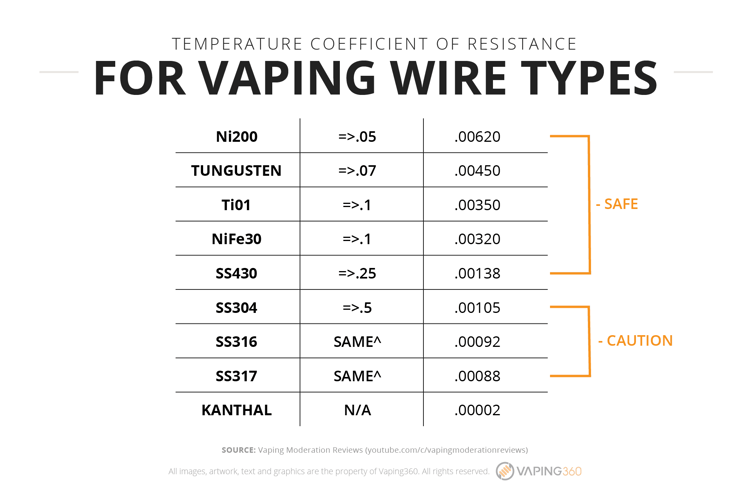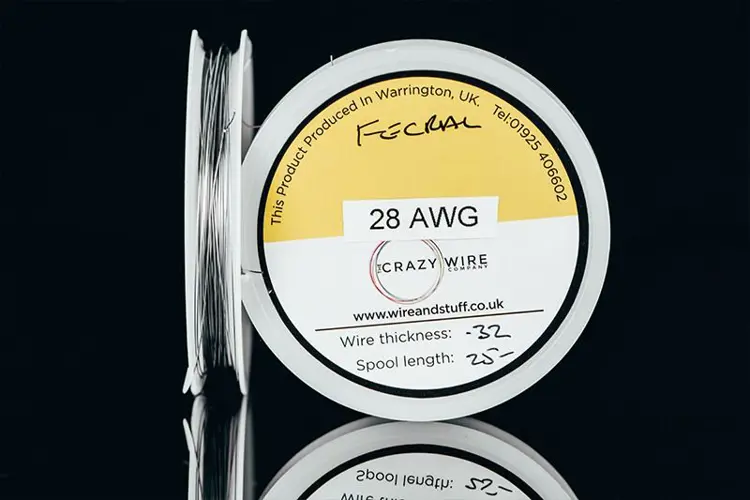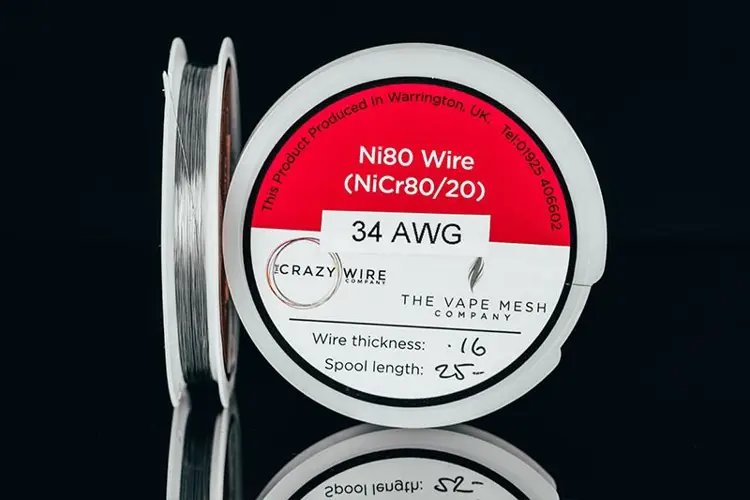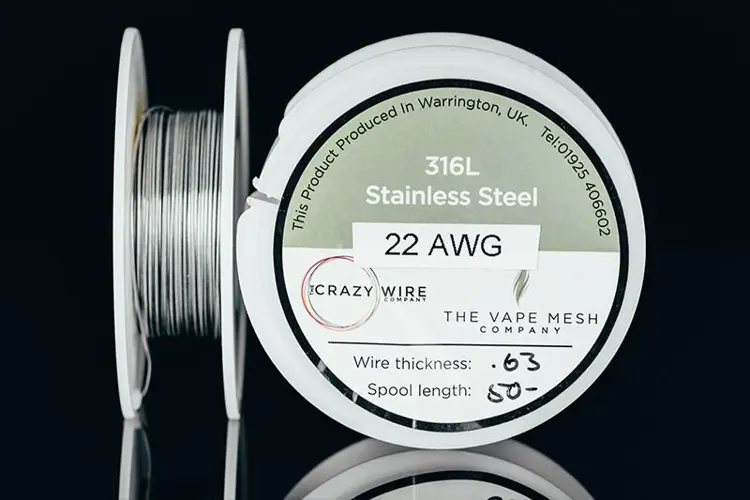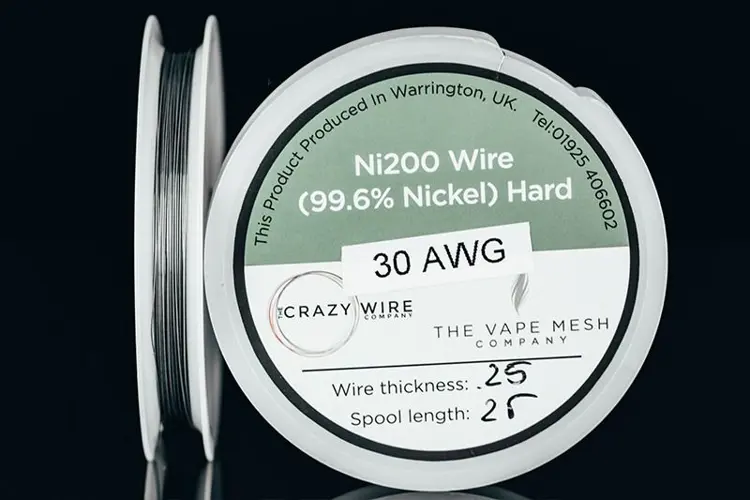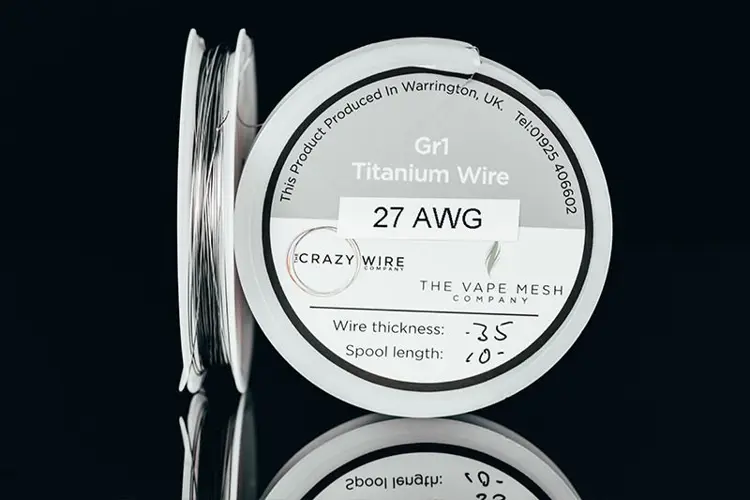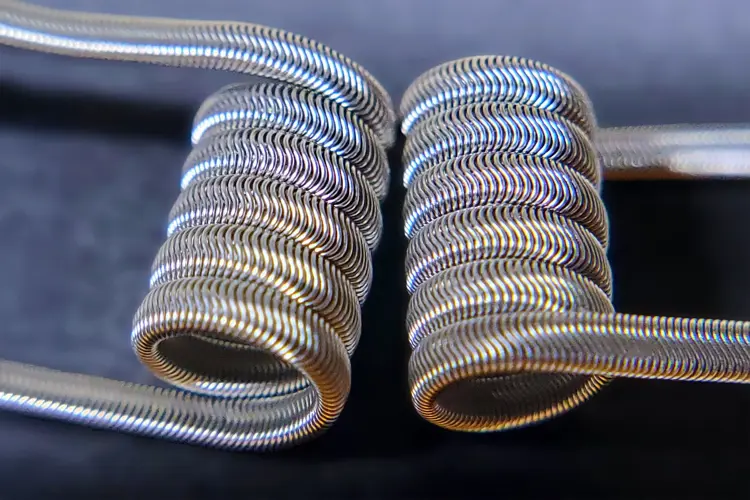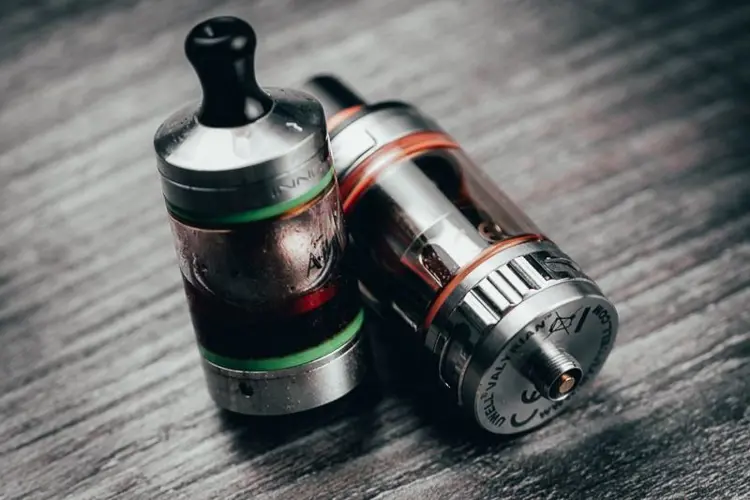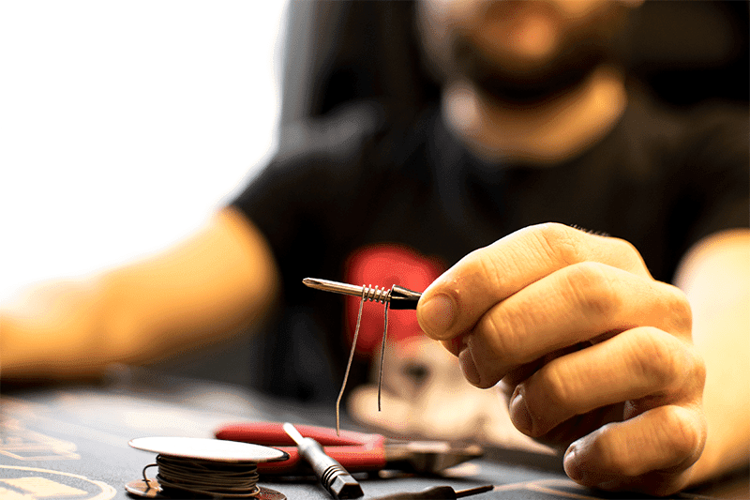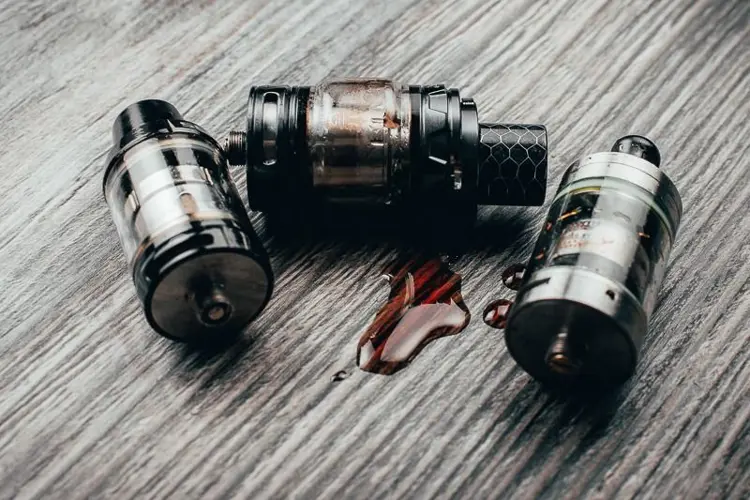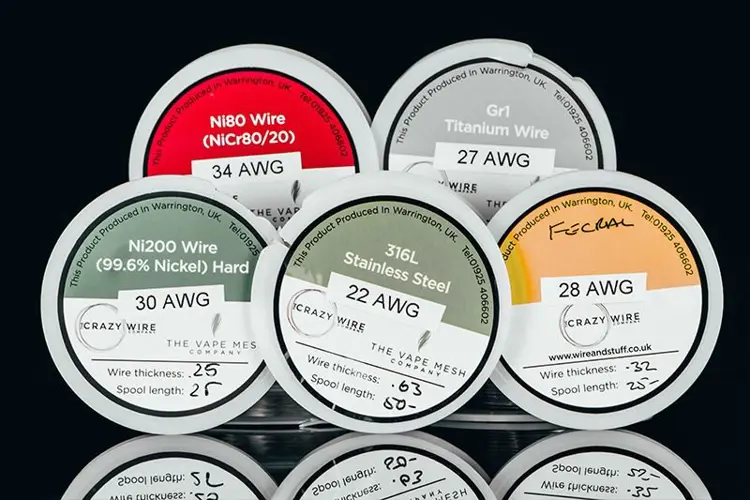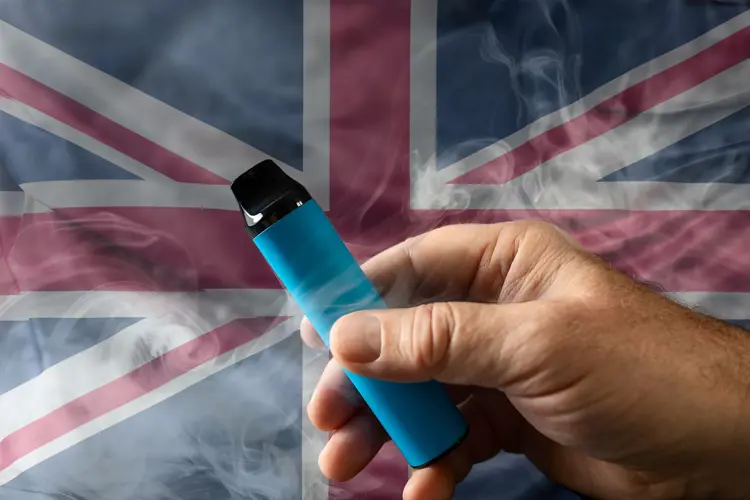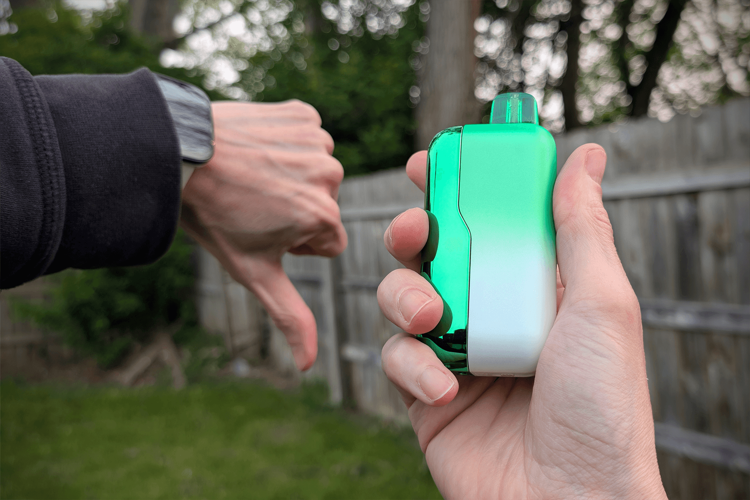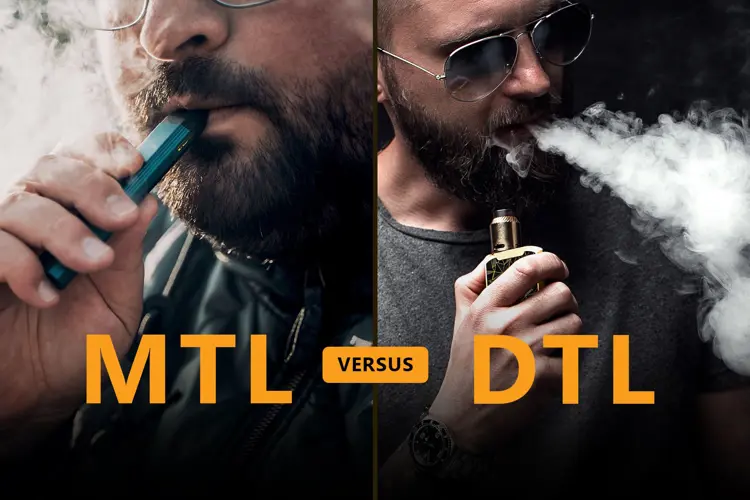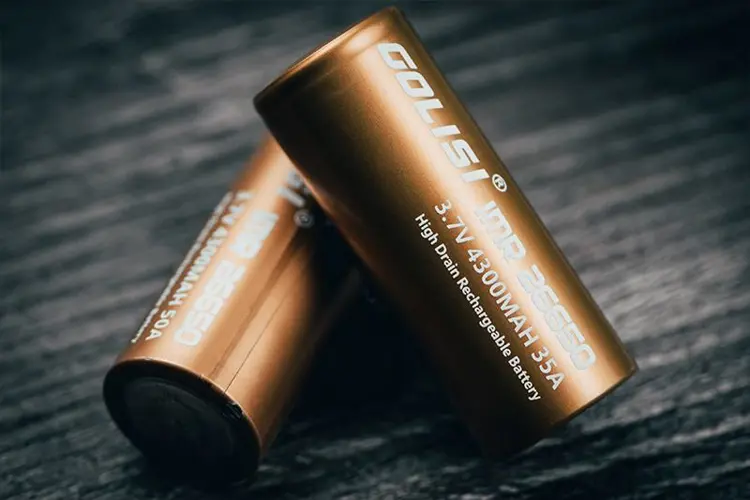Introduction
Do you know what are the most common types of vaping wire? What about their main uses and characteristics?
Some wire is used for vaping with wattage, some with temperature control, and one main type we’ll talk about can be used for both.
None of the information should overwhelm you or burden you in technical data. It’s a high-level overview. The focus will be on single-strand wire, and only on wires that are commonly used for vaping. Wires like NiFe or Tungsten can be used for vaping purposes, but you’ll be hard-pressed to source them, and they don’t actually offer advantages over the wires that are being presented here.
Wire gauge, resistance, ramp time and TCR
There are some basic characteristics that apply to all wire, regardless of the composition of it. These are the diameter (or gauge) of the wire, its resistance, and the ramp time of different materials.
Wire gauge
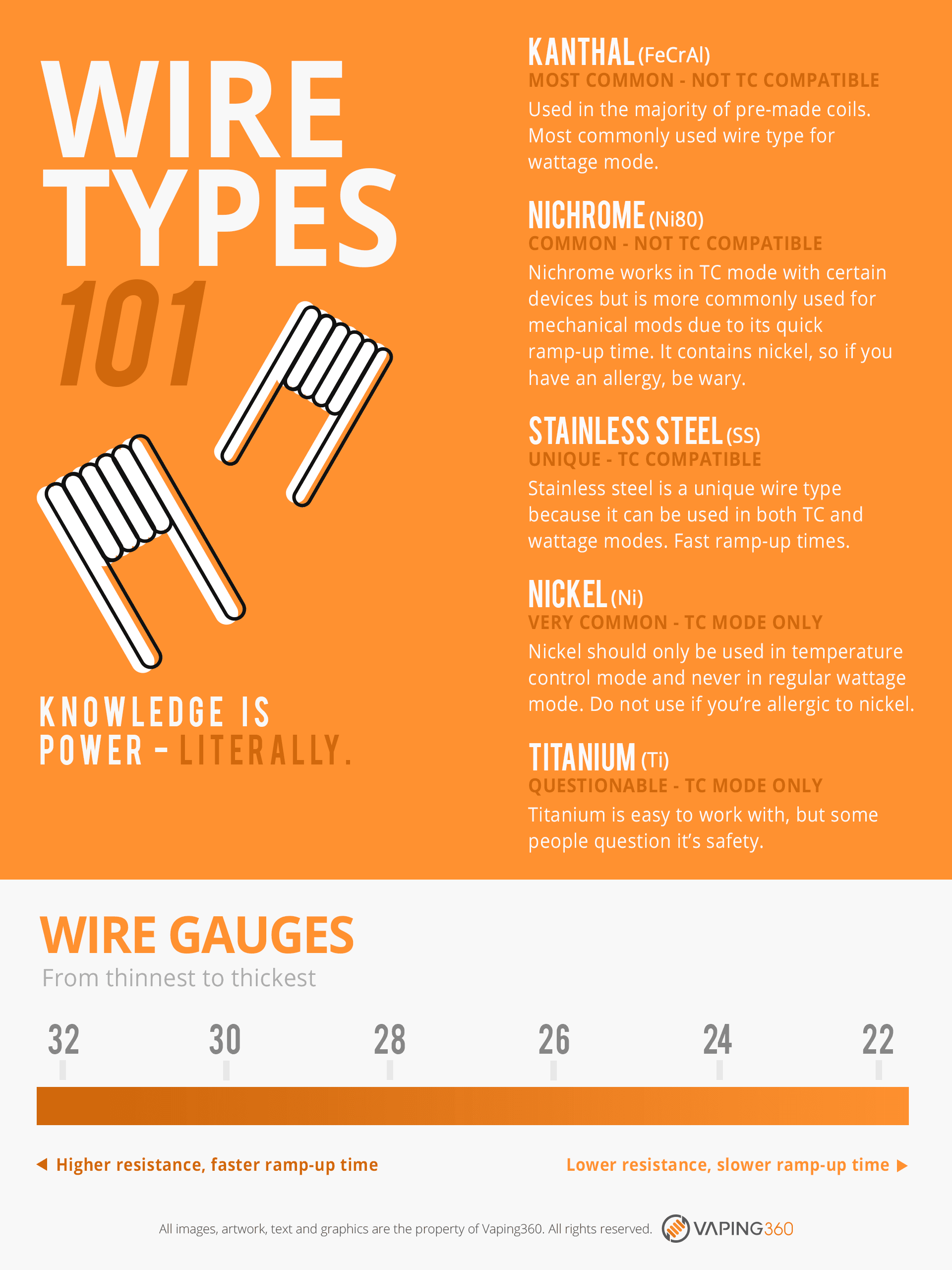
The first basic characteristic of any wire is the actual diameter of the wire. It is commonly called the wire “gauge" and expressed as a numerical value. The actual diameter for each wire isn’t really important. What matters is that as the wire gauge number increases, the wire diameter gets smaller. For example, 26 gauge (or 26g) is thinner than 24 gauge but thicker than 28 gauge. Some of the most common gauges used for single-strand coil builds are 28, 26, and 24, and thinner wire used in the exterior of Clapton coils is usually between 40 and 32 gauge. There are others of course, and even odd number gauges.
Resistance
As the wire diameter increases, the wire resistance decreases. When comparing coils with the same ID, number of wraps, and material used, a coil made with 32 gauge wire will be of much higher resistance than a 24 gauge coil.
Another factor to take into account when it comes to wire resistance is the internal resistance of the coil material. For example, a five-wrap 2.5 mm ID coil made out of 28 gauge Kanthal will have a higher resistance than a stainless steel coil with the exact same specs. This is due to the higher resistance of Kanthal compared to stainless steel.
Take note that for every given wire, the more length you use, the higher the resistance of your coil will be. This is important when wrapping coils, as more wraps will raise the resistance of your build.
Ramp-up time
You may have heard the term “ramp-up time”. Ramp-up time is the time your coil takes to reach the temp needed for vaporizing e-juice. Ramp time is generally more noticeable with exotic multi-strand wire coils like Claptons, but, as wire size increases, ramp time can also become more apparent with simple single wire coils. Generally, lower gauge wire will take longer to heat due to the larger mass. Thin gauge wires like 32 and 30 will be higher in resistance but will heat faster than 26 or 24 gauge.
Different coil materials that come with different internal resistances will also have very different ramp-up times. For power mode wires, stainless steel is the faster to ramp, closely followed by nichrome, with Kanthal being significantly slower.
TCR
In basic terms, temperature control mods rely on a characteristic of your vaping wire to detect when to regulate the current and wattage delivered to the coil. Wires suitable for TC are chosen because of their Temperature Coefficient of Resistance (TCR).
The TCR of the vaping wire is the increase in resistance of the wire as temperature increases. The mod knows the cold resistance of your coil, and the material you are using. The mod is also smart enough to know that when your coil rises to a certain resistance (as temperature rises) that the coil is too hot, and it reduces the current to your coil as required to prevent burning.
All wire types have a TCR, but the increase can only be measured reliably in TC-compatible wires (check the chart above for more information).
Kanthal
Kanthal wire is a ferritic iron-chromium-aluminum alloy with good resistance to oxidation. It is commonly used for vaping in straight wattage mode. Kanthal is a great place to start if you are just getting into rebuilding, dripping, etc. It is easy to work with, yet stiff enough to hold its shape when formed into coils—which comes into play during the wicking process. It is extremely popular as a primary wire when building single-wire coils.
Kanthal is inexpensive and widely available at most vape shops, online shops, and even eBay.
Nichrome
Another type of wire well suited for wattage vaping is Nichrome. Nichrome wire is an alloy composed of nickel and chromium, and may also contain other metals such as iron. Fun fact: nichrome has been used in dental work, such as fillings.
Nichrome comes in a variety of “grades”, with ni80 (80% nickel and 20% chromium) being the most popular.
Nichrome behaves very much like Kanthal, but has lower resistance and heats faster. It is easy to coil and holds its shape well when wicking. Nichrome has a lower melting temperature than Kanthal, so you need to be careful when dry burning your coils—they will burn open if you aren’t careful. Start low and pulse the coils. Don’t rush into it and hit them with max wattage while dry.
One other possible downside of nichrome wire is the nickel content. Folks with nickel allergies may want to avoid using nichrome for obvious reasons.
Nichrome used to be less common than Kanthal, but has risen in popularity and is very easy to find at vape shops or online.
Stainless steel
Stainless steel is the most unique of the common vaping wires. It can pull double duty and be used for straight wattage vaping or temp control vaping.
Stainless steel wire is an alloy composed primarily of chromium, nickel, and carbon. The nickel content is usually between 10-14%, which is not that high, but people with allergies should not take the risk. There are many variations (grades) of stainless steel, expressed numerically. For coil building, SS316L is by far the most commonly used grade, followed by SS317L. Other grades like 304 and 430 are also used sometimes, but not so often.
Stainless steel is easy to form and holds its shape well. Like nichrome, it offers a faster ramp time than Kanthal due to its lower resistance for the same gauge. Take note to not dry burn stainless steel at high wattages when checking for hotspots or cleaning your build, as this might lead to the release of unwanted chemical compounds. A good workaround is to build spaced coils that don’t need to be pulsed for hotspots.
As with Kanthal and nichrome, stainless steel coils can be easily found in B&Ms as well as online.
Kanthal vs. nichrome vs. stainless steel (wattage)
Most vapers prefer power mode: it is just simpler. Kanthal, stainless steel, and nichrome are the three most popular power mode wires right now, and you might be wondering what would be the best one for you. Again, take note that if you have (or suspect you may have) a nickel allergy, then you should not vape on nichrome coils, and maybe you should also avoid stainless steel.
Kanthal has been the choice of most vapers for a longer time, due to its ease of use and higher resistance. Mouth to lung vapers appreciate their higher builds, and a 26-28 gauge Kanthal wire is always dependable—and hard to swap for anything else. Lower ramp-up time can even be a plus for MTL vapers that like to take slow and long puffs.
Nichrome and stainless steel on the other hand are excellent power mode wires for vaping at lower resistances—that’s not to say that they can’t be used for all kinds of inhales. And while flavor is very subjective, many vapers that try nichrome or stainless steel swear that they get better flavor than they did with their previous Kanthal builds.
Nickel
Nickel wire, also referred to as ni200, is generally pure nickel. Nickel wire was the first wire used in temperature control, and is the first wire in this list that cannot be used in wattage mode.
There are two major drawbacks with ni200. First, nickel wire is soft and can be difficult to work into uniform coils. Once mounted, the coils can easily deform when wicking.
Second, it’s pure nickel, which some people might be uncomfortable vaping on. On top of that, many people do have a nickel allergy or various degrees of sensitivity. While stainless steel also has nickel in its alloy, it is not the primary component. If you belong in the above category you should stay away from nickel and nichrome, and be cautious with stainless steel.
Nickel wire may still be very popular with TC enthusiasts and is relatively still easy to find locally, but it might not be worth the hassle.
Titanium
The last wire we will look at is titanium, which is another TC-only wire.
There is some controversy surrounding the safety of titanium wire when used for vaping. Heating it can release a toxic component (titanium dioxide) above 1200 ℉ (648 ℃). Also, like magnesium, if titanium ignites it is extremely difficult to extinguish. Some shops will not even sell the wire due to liability and safety issues.
Note that folks still commonly use it and that, theoretically, if your TC mod is doing its job, you should never have to worry about combustion or titanium dioxide poisoning. It should go without saying, but do not dry burn Ti wire!
Titanium is easy to work into coils and easy to wick. But it might be hard to source due to the abovementioned reasons.
Stainless steel vs. nickel vs. titanium
Stainless steel is a clear winner between TC-compatible wires. It’s easy to source, easy to use, and even works in power mode if needed. On top of that, its nickel content is relatively low. While people with nickel allergies should avoid it, it is less likely to cause adverse reactions to people with moderate nickel sensitivity—but you should always play it safe.
All things considered, if you have a nickel allergy or sensitivity, using a TC wire is probably not the best idea. Our advice is to stick to wattage vaping using Kanthal, which is also the most commonly used wire for vape coils on the market.
Final word
The bottom line is that your choice of vaping wire is an important variable in finding your vaping nirvana. In fact, it’s one of the components that have the greatest impact on your vaping experience. Varying the wire type and gauge allows us precise control over ramp time, current, wattage, and ultimately the pleasure we derive from vaping. By varying the number of wraps, coil diameter, and wire type, you can create a whole new experience. Once you find something that works with a particular atomizer, jot down the specifics and save the specs for future reference.
President Trump promised during his election campaign to “save vaping," but his administration has undermined that goal at every turn.
The U.S. disposable vape market has grown to $2 billion in annual sales, although nearly none of the products are authorized by the FDA.
More than 30 bills that would impose severe restrictions vaping consumers’ product choices remain active in U.S. state legislatures.
The Freemax REXA PRO and REXA SMART are highly advanced pod vapes, offering seemingly endless features, beautiful touchscreens, and new DUOMAX pods.
The OXVA XLIM Pro 2 DNA is powered by a custom-made Evolv DNA chipset, offering a Replay function and dry hit protection. Read our review to find out more.
The SKE Bar is a 2 mL replaceable pod vape with a 500 mAh battery, a 1.2-ohm mesh coil, and 35 flavors to choose from in 2% nicotine.

